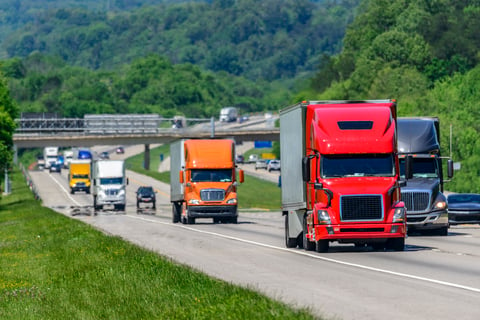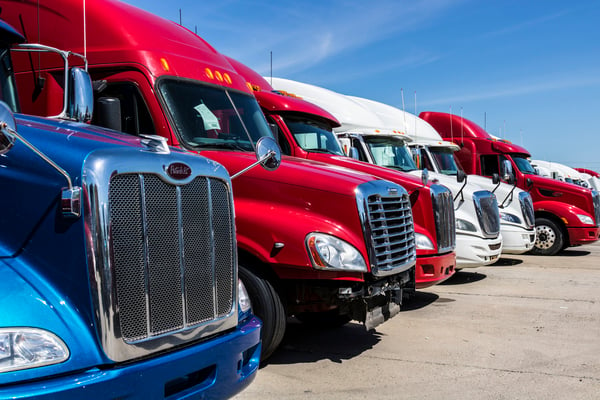
The transportation sector includes companies that move people, products, and other goods across the United States to various destinations, and it takes millions of workers to make it all possible.
Several specific sub-sectors are included in the transportation category, including air, rail, marine, truck, transit and ground, scenic and sightseeing, and support activities. As an integral part of transportation, infrastructure and logistics are also counted as part of the sector.
These categories and subcategories are made up of private and public companies like airlines, shipping and trucking services, and other essential transportation businesses that keep America moving.
 Heavy traffic on the interstate. Photo courtesy of iStock/WendellandCarolyn
Heavy traffic on the interstate. Photo courtesy of iStock/WendellandCarolyn
Why is it important?
Everyone—everyone—is touched by the transportation sector. Whether traveling by plane or car, bus or buggy, we rely on the roads, rules, and carefully designed infrastructure of the transportation industry to get us to our destinations.
Ordering from Amazon? Thank the transportation industry for delivering to your doorstep. Shopping at the supermarket? Each and every one of those goods for purchase arrived by truck, freight, or air. Even local products depend on delivery trucks and roadways.
This adds up to the transportation sector having a direct impact on our economy. When shipping costs are steady, the price of goods remains steady. But if transportation costs increase or decrease, consumers often see it directly reflected in product costs.
What causes transportation prices to fluctuate? Increases or decreases in the costs of labor and fuel and changes in government regulations are factors that can impact prices and company earnings.
Here’s an example: The price of air travel in 2019 was at an all-time low—domestic fares in the U.S. were the lowest on record in the third quarter of 2019. Part of that is due to the no-frills budget fares now offered by most domestic airlines, but it’s also helped by a decrease in the cost of oil. Lower fuel costs mean a smaller operating budget for airlines, leading to an increase in profit, a boost in company stock, and a chance to sell cheaper tickets to happy flyers.
What is the DJTA?
Dow Jones Transportation Average (DJTA) was the first U.S. stock market index, outdating even the infamous Dow Jones Industrial Average. Compiled by Charles Dow in 1884, the initial DJTA consisted of 11 businesses, 9 of which were railroad companies.
Today’s DJTA is made up of 20 companies chosen to represent the transportation industry, including trucking, logistics, delivery services, airline, rental and leasing services, marine transportation, and, of course, railroads. With the longest track record of any index tracking U.S. stocks it still serves as the most widely recognized measurement of the American transportation sector, followed by the S&P Transportation Select Industry Index, which is considered a secondary benchmark.
Tanker Trucks, Aviation, and Rail – A Second Look
Because of the sheer size of the transportation industry, covering every aspect of it would be an impressive feat, so let’s take a closer look at three sub-sectors in particular: air, rail, and truck transportation.
Tanker Truck Transportation
 Semi-tractor-trailer trucks lined up. Photo courtesy of iStock/jetcityimage
Semi-tractor-trailer trucks lined up. Photo courtesy of iStock/jetcityimage
The trucking industry is the largest single section of the transportation sector. Accounting for 48 percent of the entire transportation sector’s employment, the trucking industry employs nearly as many people as the other subsectors combined. Many consider the trucking industry to be the backbone of the American economy: trucks move almost 71 percent of all freight tonnage, amounting to 10.5 billion tons annually.
Despite that, the future of trucking is hazy, with many predicting a rough year ahead. Roughly 795 trucking companies failed throughout 2019, but experts are divided on whether that trend will continue this year. Tariffs, trade wars, and the COVID-19 pandemic have slowed the economy. So, we’ll have to wait and see how things shake out.
A potential increase in fuel prices could cause problems for the trucking industry. Because of IMO 2020 (a new regulation on the amount of sulfur that can be emitted from water vessels) trucks and ships could end up competing for the same fuel. U.S. trucks are already using low-sulfur diesel, but their supply could dry up if marine ships start dipping into the same barrel. It’s classic economics: demand for low-sulfur diesel is predicted to rise, causing supply to decrease, forcing prices to skyrocket.
Autonomous vehicles are also predicted to have a big impact on the future of trucking. While it may sound like a scene out of a sci-fi movie, self-driving trucks could be here in the next decade. A few manufacturers have already begun testing on roads in Virginia.
Unlike human drivers, self-driving vehicles won’t need to take breaks to rest, sleep, and eat. The current Hours of Service (HOS) regulation requires truckers to have 10 consecutive hours off before driving a maximum of 11 or 14 hours, which is monitored by mandatory Electronic Logging Devices (ELD). A few changes to HOS are expected to come down the line in 2020, but unless humans stop needing sleep in the future, autonomous machines will be a tempting option for shipping companies looking to limit downtime.
Aviation Transportation
 Dulles Airport in Washington, DC. Photo courtesy of iStock/narvikk
Dulles Airport in Washington, DC. Photo courtesy of iStock/narvikk
For quick transport, air travel is hard to beat. And in today’s global economy, it’s little wonder that we rely heavily on aviation in the transportation sector—it’s one of the fastest-growing industries. Annually, America moves 44.3 billion pounds of freight and one billion passengers through the 5.3 million square miles of domestic airspace.
Air transport plays a vital role for international travelers, making the world accessible in a way it’s never been before. More than four billion people traveled by air in 2018, boosting tourism and stimulating economies around the globe—especially in developing countries.
Worldwide, the aviation industry employs 62.7 million people.
With climate change and carbon emissions on everyone’s radar, the future of aviation is looking green. Several airlines are working toward environmentally friendly travel, and sustainable jet fuel is primed to take off. In February 2020, aviation chiefs in the United Kingdom announced a plan to reach net zero emissions by 2050 while continuing to accommodate the forecasted growth.
Rail Transportation
 Railroad train departing Detroit. Photo courtesy of iStock/JerryB7
Railroad train departing Detroit. Photo courtesy of iStock/JerryB7
Railway transport brings us back to where it all began: the rail industry. Today’s railroads are not the same as Dow’s, yet they beg the question: could the transportation of the past be our future?
Trains are fast and efficient, and rail companies are embracing cutting-edge technology. Rail is one of the most efficient ways to move people and products. By itself, America makes up roughly 25 percent of all freight activity. Globally, 75 percent of passenger trains operate using electricity. North America still relies mostly on diesel to power train operations, but an electric future is certainly possible.
Amtrak, too, recently broke even reporting a record of 32.5 million passengers for 2019 with most of the gains in ridership coming from Amtrak’s Northeast Corridor. With travelers concerned about the environmental impact of flying, passenger trains are beginning to grow in popularity. Maybe a high-speed transcontinental railroad will be built in the next several decades.
Freight railroads are also moving to harness the power of technology, though digitizing the rail industry comes with its own complications. Cybersecurity poses a threat to almost every aspect of American life (anyone who has discovered fraudulent charges on their credit card can attest to that), but a rail accident caused by hackers could cause real, physical harm to many people. Hackers could also target shipping freighters, halting progress, disrupting the supply chain, and causing general chaos. In response, railroads are taking a “proactive, multi-pronged approach to prevent and provide resiliency against cyber threats,” according to a spokesman from the Association of American Railroads.
Supporting the Transportation Sector
Whether by air, rail, or road, Dixon supports the transportation sector.
Our manufacturing centers create the best in liquid and dry material transfer products like railcar connectors, cam and groove, overfill protection alarms, drop elbows, API fittings, and valves for all these markets. We pride ourselves on understanding your industry, your challenges, and your future, so we can help you keep America moving.
To reach a Dixon specialist and learn how we can help you address a specific challenge, email us or call us at 877.582.3569.
Sources:
- https://www.investopedia.com/terms/t/transportation_sector.asp
- https://www.bts.gov/newsroom/third-quarter-2019-air-fare-data
- https://www.economicmodeling.com/2012/07/05/industry-overview-air-rail-water-and-road-transportation-2001-2012/
- https://www.trucking.org/News_and_Information_Reports.aspx
- https://www.ccjdigital.com/2020-trucking-industry-forecast/
- https://www.foxbusiness.com/markets/2020-trucking-industry-outlook
- https://www.cnbc.com/2019/09/10/self-driving-trucks-are-being-tested-on-public-roads-in-virginia.html
- https://www.faa.gov/air_traffic/by_the_numbers/
- https://www.statista.com/topics/1707/air-transportation/
- https://www.iea.org/reports/the-future-of-rail
- https://www.freightwaves.com/news/regulations-prompt-freight-rail-sector-to-address-cybersecurity
- https://investinganswers.com/dictionary/d/dow-jones-transportation-average-djta
- https://www.greenwichtime.com/technology/businessinsider/article/At-least-2-500-truck-drivers-have-lost-their-jobs-14096395.php
- https://www.wsj.com/articles/trucking-company-shutdowns-grow-as-shipping-market-cools-11567104495


